Exchange
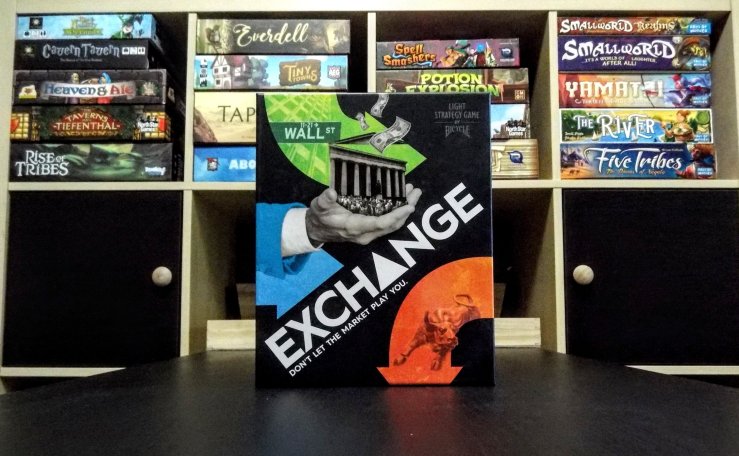
- Designer: Eric Sillies
- Publisher: Games by Bicycle
- Players: 3-6 Players
- Age: 10+
- Time to play: 35 Minutes
Hey folks! Back again with another game. This time we’re looking to invest, buy, and sell. We’re watching the market and trying to sell when the market is just right. We’ve got bonds, insurance, and banks that we’re investing in. Can you be the player with the most net worth at the end of the game? We’re looking at Exchange by Games by Bicycle. This is a simultaneous selection economics game where what players do will change the market.
Components

- 54 Phase 2 Buy or Sell Cards
- 40 $10 Cards
- 35 $50 Cards
- 25 $100 Cards
- 21 Phase 3 Influence Cards
- 18 Phase 1 Select Security Cards
- 15 Market Forces Cards
- 12 Founder Cards
- 6 Ledger Boards
- 6 Phase 1 Sleeves
- 6 Phase 2 Sleeves
- 6 Phase 3 Sleeves
- 1 Lobbyist Sleeve
- 1 Round Token
- 1 Banks Token
- 1 Bonds Token
- 1 Insurance Token
- 1 Market Value Board
Set Up

- Place the Market Value Board in the center of the table.
- Shuffle and place the 15 Market Forces cards face down to the left of the board.
- Place the lobbyist sleeve and set of 3 Phase 3 Cards inside of it to the right of the board.
- Place the money cards in separate stacks beneath the board.
- Place the Banks, Bonds, and Insurance Tokens on the $50 column on the board.
- Place the Round Token on the 1 space at the bottom of the board.
Each player sets up by doing the following.
- Take a Ledger Board.
- Take a Phase 1, Phase 2, and Phase 3 sleeves.
- Take Phase 1 Banks, Bonds, and Insurance cards.
- Take Phase 2 cards valued 1-9.
- Take Phase 3 Banks, Bonds, and Insurance +/- cards.
Lastly, shuffle the Founder Cards and deal one to each player.
Players will adjust the ledger board to match the founder card and take the amount of cash shown at the bottom.
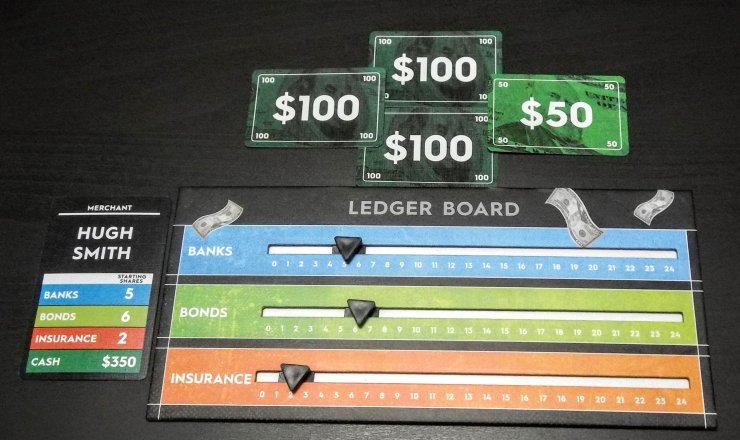
Game Play
This game is played over 5 rounds. Each round has 3 Phases then the market adjusts and the players buy or sell securities (Banks, Bonds, or Insurance.)
Phase 1 – Security Selection
Players will secretly pick what security they want to buy or sell. Once they’ve chosen, they will place in in the phase 1 sleeve face down.
Once all players have chosen a security, all players reveal it simultaneously.
Phase 2 – Buy/Sell
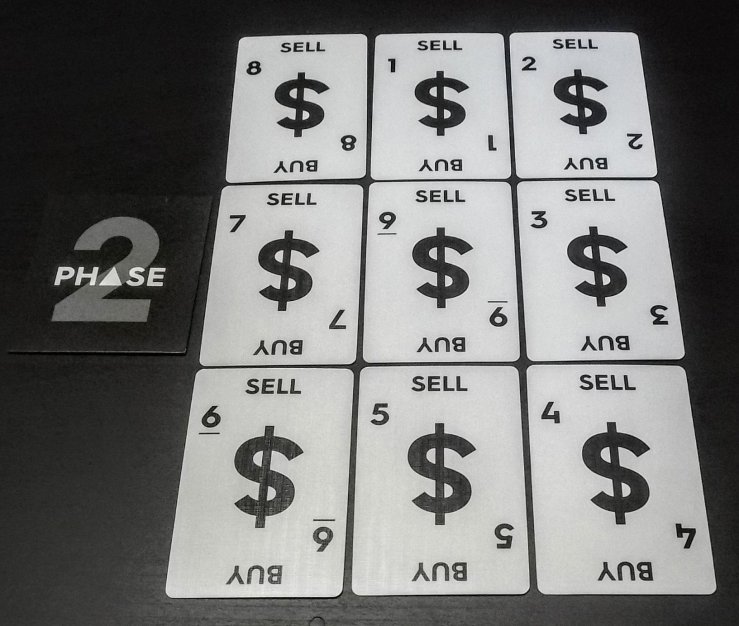
Players will secretly pick how many shares to buy or sell. Pick the amount and have the buy or sell on showing on top when sleeved. Place these face down, they will be revealed at the end of the round.
Once all players have chosen to buy or sell, all players reveal it simultaneously.
Phase 3 – Market Influence
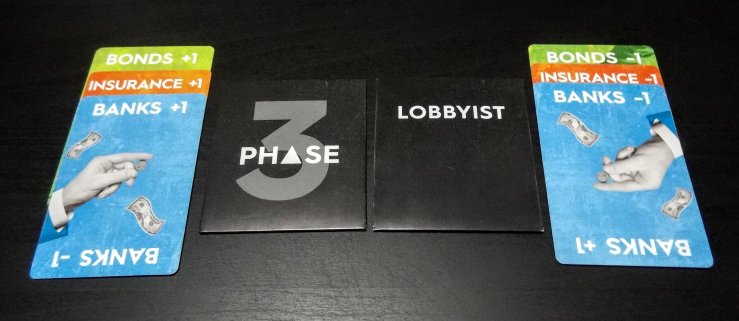
Players will secretly pick what security to influence. Pick either +1 or -1 for the security you want to influence. When you choose what to influence, place the card in the sleeve and place it face down.
Once all players have chosen a security to influence, all players reveal it simultaneously. Then you adjust the security on the market value board. If the security selected is + then move the corresponding token up on the board. If the security selected is – then move the corresponding token down on the board.
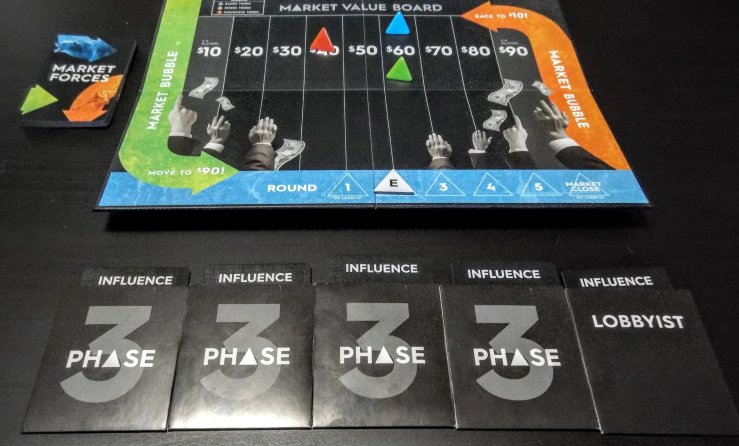
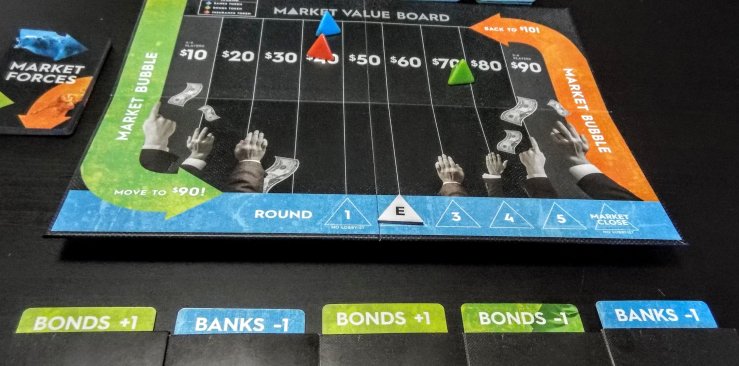
Draw and reveal the top Market Forces card. Resolve the card accordingly.
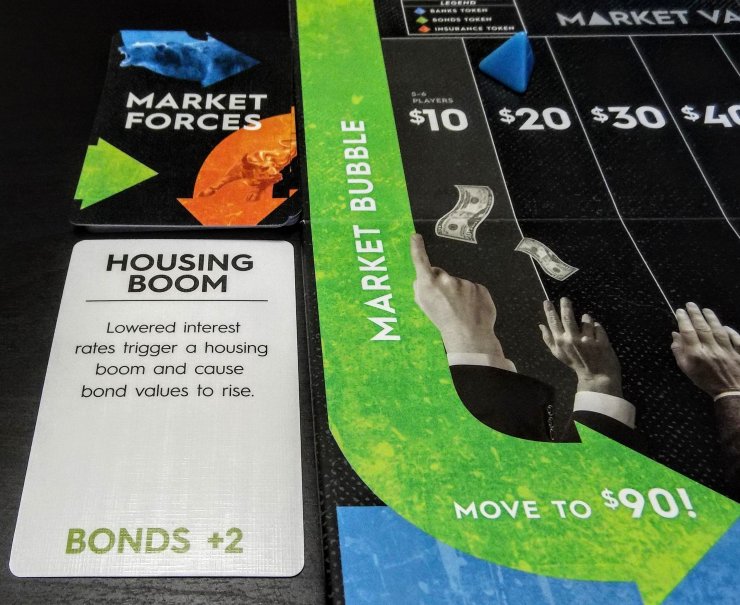
Market Bubble – If the market shifts where it drops a security either above the highest value or below the lowest value the market bubble “pops” for that security. It will flip over to the opposite side of the board. Going from lowest to highest value or highest value to lowest value.
Market Intelligence – A player may pay $50 to look at the top Market Forces card at any time.
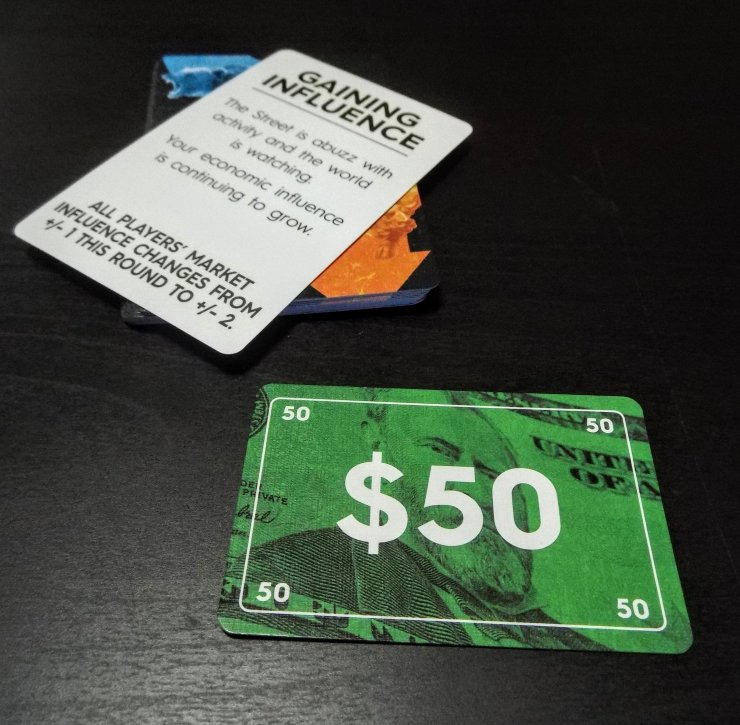
Lobbyist – After round 1, the player with the most cash is the lobbyist each round. The lobbyist lets you influence the market a second time during Phase 3.
Buy and Sell
After adjusting the market, players will reveal the amount of securities being bought or sold from Phase 2. Each player adjusts their ledger board accordingly.
Sell – You get money based on what money column the security market is located. Decrease the number of amount you’re selling on your ledger and then take that much cash from the bank.
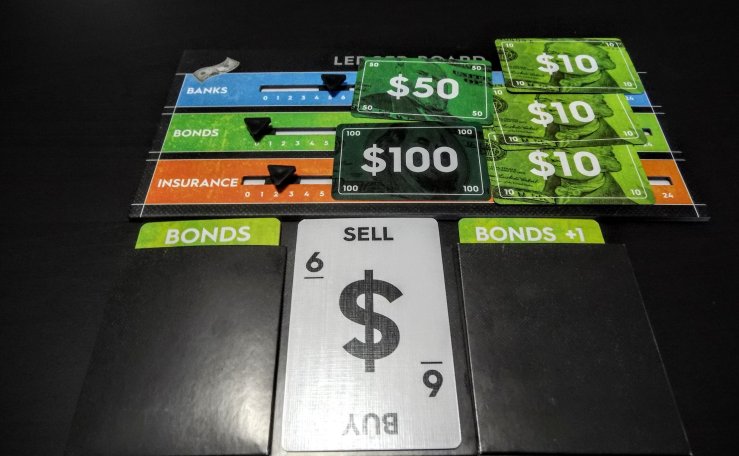
Buy – You pay money based on what column the security marker is located. Pay the bank that amount, and move your security up that amount on your ledger.
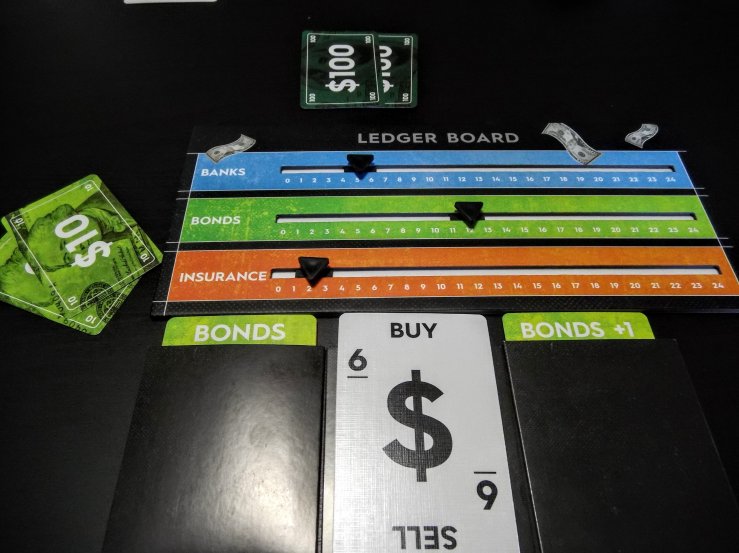
If you go to buy, and the market has shifted and you don’t have enough money you have to liquidate some existing assets to pay off the debt. Sell a security for half price until you cover the debt. It’s your choice on what security to sell. If after selling all your assets and you still cannot pay off the debt you are eliminated from the game.
Market Close
After 5 rounds, there is one last time to influence the market. There is no lobbyist during this final influence. Complete Phase 3 again. After the market board is adjusted, it’s time to score your net wealth.
Look at your shares in a security and sell them for the price on the market board. If you have 7 shares of Banks and Banks is at $70, you would have $490 value for Banks. Do the same for Bonds and Insurance. Add all three together and add in your cash. That’s your total net worth.
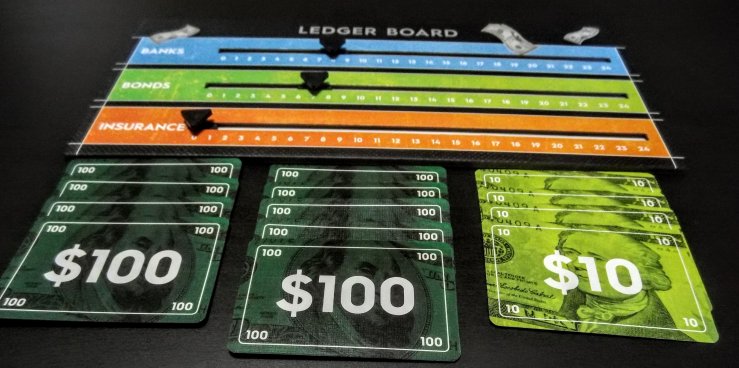
The player with the highest net worth is the winner.
Final Thoughts
We’ll start with the components. Bicycle is known for their cards and that translates to this game. The card quality is really nice. I like that this game doesn’t use paper money. Paper money has been one of my pet peeves in games. It rips, gets wrinkled, creases, and easily blows away. Rant over, back to this game. The decision to use cards for the money is a good one. It wasn’t until actually taking the pictures for this review that I noticed the art on each amount is the correct President for that bill. The bills and the Phase 1 and 3 cards are really the only art in the game. There’s a lot of font, and the font is thick and bold. One thing I would have liked to see more of is color to draw people in. A lot of this game is the color black. Phase 1 and 3 cards have some color, but phase 2 seems to be lack luster in the visual department.
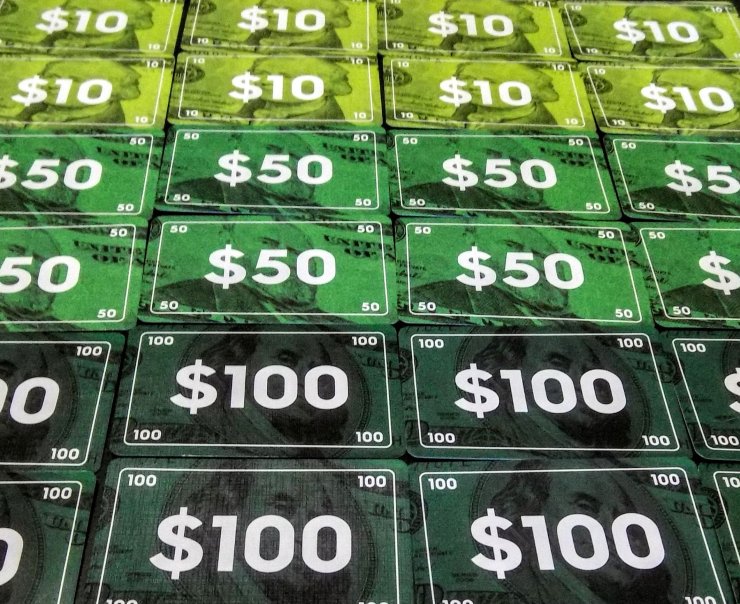
I’m a fan of the ledger boards. They are of nice thickness, the numbers are easy to see, and the sliding pointers are easy to move. It’s a nice alternative to moving cubes up and down, taking resources, or collecting cards. It fits and works well with the game.
Game play is faster than I was expecting. The breakdown of the phases was pretty easy and once everyone got used to it, it moved along pretty fast. I know the idea is to read the other players and do the phases simultaneously. My group started to do the phase 1 and 2 at the same time before revealing them. I feel like most players have a set idea of what they want to do. I can see the benefit of knowing what everyone is picking for phase one though. If too many people are picking the same security, the market might be too unpredictable. You might not want to buy too much if the market is unpredictable.
The different phases seem nice a fluid. It makes sense for the order that they happen. The one thing I don’t think any player has done was the market intelligence. Paying $50 to see an event that can’t be skipped can be beneficial, but it was something that was easily forgotten. $50 in this game is a starting security share. For me, I’d rather be smart with the cash and try to secure the Lobbyist role. Speaking of the lobbyist, I like that it adds a little more control over the market and that it is only after the first round and doesn’t effect the final market influence.
This is a game that I wasn’t sure how it was going to be. The first time I played it, it was the lowest player count. Like all the games I review, I knew I had to play it at different player counts to really get the feel for it. I can say, don’t play this at 3 players. While some people might enjoy it, I feel like this game comes more alive with more players fighting to adjust the market. With 3 players, there are times when everyone is going for a different security. This game gets more interesting when multiple players are looking to influence the same securities.
I can see people who enjoy the parts of Monopoly of buying properties and collecting rent liking this game. It’s a compact, fast game where the player with the most money wins. You’re not using dice to move around a board, but the randomness of players influencing the market and the market force makes this game as predicable as dice rolling for movement. If you’re into budgeting, saving, and accounting I think you’ll like this game. Is this a game that everyone will enjoy and like? I don’t think so. It’s a fluid and well thought out game. It’s just not one that was a big hit with my group. It’s easy and fast to play, but this one will be one that isn’t brought out too often.

